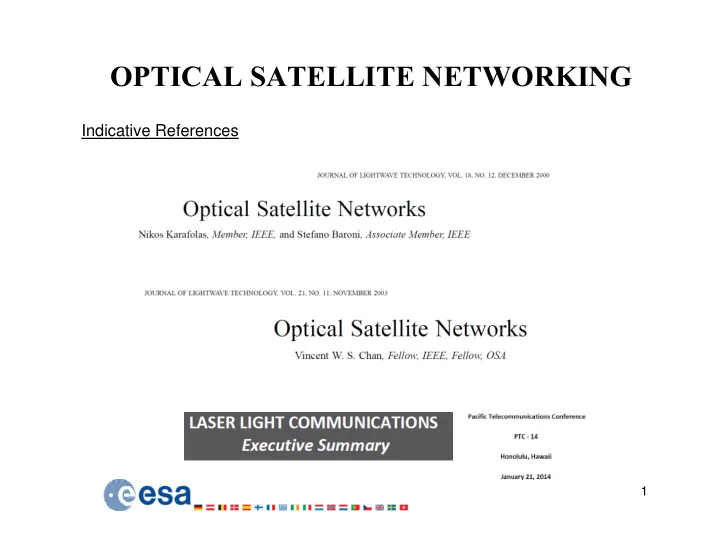

OPTICAL SATELLITE NETWORKING Indicative References 1
What is a network? It takes 2 “nodes” to have a “link” It takes minimum 3 “nodes” to have a “network” If the nodes are satellites and the links are optical we have an “Optical Satellite Network” 2
to form an Optical Satellite Network We need: • A constellation of satellites ( or “nodes”) • Optical Inter-satellite Links • Satellite to Ground to Satellite Links can be either • RF links (access to end-users and TELCO operator’s Ground Stations) or • Optical Links (only for TELCO operator’s Ground Stations) 3
Satellite Constellations can be formed in different orbits: LEO-MEO-GEO Latency is of great concern especially when compared to terrestrial fiber based latency for the most delay-sensitive application like voice/video-conference. • GEO is longer than fiber delay MEO is similar to fiber delay • LEO is smaller to fiber delay • Remember light travels at 300.000 km/sec in free space • at 200.000 km/sec in an optical fiber • 4
GEO the first Optical Satellite Network proposal “a global 3-nodes GEO ring topology-Clarke Network” proposed by Arthur Clarke in October’s 1945 issue of “Wireless World” …The stations in the chain would be linked by radio or optical beams, and thus any conceivable beam or broadcast service could be provided…” 5
MEO (bent-pipe) The O3B constellation (video 1.46 min) https://www.youtube.com/watch?v=ehM7FG1oB9Y 6
LEO constellations (bent-pipe) Gloablstar (video network-coverage simulation 0-1.34 min) https://www.youtube.com/watch?v=G8VPEueequM 7
LEO (with ISLs i.e a “Satellite Constellation Network”) Constellation run (video Iridium Network run - Seam Visible 2.00 min) https://www.youtube.com/watch?v=MGJal5uPXRA&list=PLedMFUaKH9DkwVY-q-ulAVBXWeM-Yto9F&index=8 End to end Communications (video maritime Iridium 0.58 min) https://www.youtube.com/watch?v=AdoxXqMiwGo&list=PLedMFUaKH9DkwVY-q-ulAVBXWeM-Yto9F&index=7 8
These Satellite Constellation Networks are the ones of interest to apply • Optical inter-satellite links • Optical on-board routing and hence form an “Satellite Optical Transport Network” similar to “Terrestrial Optical Transport Network” and “Submarine Optical Transport Network” 9
How an “optical satellite constellation network” is formed? SATELLITE NETWORK PHYSICAL TOPOLOGY Decide the orbit LEO-MEO-GEO ( the lower the orbit the more satellites are needed • for global coverage – impact on elevation of ground antenna ) Decide number of orbital planes and inclination • Decide number of satellites/orbital plane • Decide on launching policy π or 2 π and “ phasing ” (i.e. spacing) • Decide number of ISLs per satellite • Decide which satellites will be linked with ISLs • 10
2 main physical topologies • Ring • Mesh 11
Example: Α ring of satellites (O3B type) can form network topology of either: - a Ring (2 ISLs/sat) - a Mesh(4 ISLs/sat) 12
for LEO and truly global coverage a grid of tens/hundreds satellites is required 13
14
15
π Mesh Constellations 6 orbital planes (space by 30 deg) 11 satellites per orbital plane 4 ISLs/per satellite with 3 at the “network seam” Altitude 781 km Orbital Period 6013 sec Inclination 86.4 16
2 π Mesh Constellations 17
The concepts of a Satellite Optical Transport Network based Wavelength Division Multiplexed ISLs and On board Wavelength Selecive Routing 18
Wavelength Division Multiplexing 19
The idea of WDM Links and Wavelength routing via Wavelength Selective Optical Crossconnect en.wikipedia.org/wiki/Optical_mesh_network 20
The concept of “lightpath” 21
A lightpath can link directly one satellite with another through intermediate ones 22
a Satellite Payload WDM ISLs and W-S OXC 23
A satellite WDM OTN 24
Some key Networking and Communication Traffic Management considerations 25
26
27
The earth by night tells us some things about tele-traffic 28
29
30
31
Technological Considerations 32
Newly Proposed Systems 33
34
35
Access OGS in various points with spatial diversity so as to increase the availability to acceptable levels 36
37
38
Bloomberg Business Week 1 February 2015 39
The 2 new proposals X-Space • Google and Fidelity Investment 1 B$ • 4000 satellites • LEO @ 1100 km • with optical links? • To be launched by SpaceX launchers • To operate by 2020 OneWeb • Virgin Galactic and Qualcomm • 648 satellites • LEO@1200 km • To be launched by Virgin Galactic Launcher One S/C • To operate by 2018-20 40
and in Summary The first RF Satellite Constellation Network , IRIDIUM, operates since 1999 in LEO The first Optical Trunk Satellite Network, LaserLight, is currently under construction and to be operational by 2017 in MEO Two proposed LEO Constellation Networks are to fly by 2020. Optical ISLs are considered which may created an Optical Internet Access Network in the Sky
Thank you all for attending ! and for more information Send me an email at : Nikos.Karafolas@esa.int and study the Proceedings of the “International Conference on Space Optics – ICSO” www.icsoproceedings.org They are accessible by everyone free of charge ! 42
Recommend
More recommend